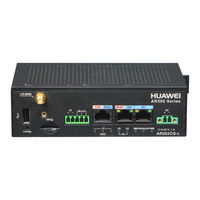Huawei AR530 Series Manuals
Manuals and User Guides for Huawei AR530 Series. We have 8 Huawei AR530 Series manuals available for free PDF download: Configuration Manual, Hardware Installation And Maintenance Manual, Product Description, Quick Start Manual
Huawei AR530 Series Configuration Manual (409 pages)
Industrial Switch Routers Ethernet Switching
Brand: Huawei
|
Category: Network Router
|
Size: 8.04 MB
Table of Contents
Advertisement
Huawei AR530 Series Configuration Manual (310 pages)
Industrial Switch Routers
Brand: Huawei
|
Category: Network Router
|
Size: 5.27 MB
Table of Contents
Huawei AR530 Series Product Description (141 pages)
Series Industrial Switch Routers V200R008
Brand: Huawei
|
Category: Network Router
|
Size: 3.78 MB
Table of Contents
Advertisement
Huawei AR530 Series Configuration Manual (117 pages)
Industrial Switch Router
Brand: Huawei
|
Category: Network Router
|
Size: 1.55 MB
Table of Contents
Huawei AR530 Series Hardware Installation And Maintenance Manual (219 pages)
Industrial Switch Routers
Brand: Huawei
|
Category: Network Router
|
Size: 16.16 MB
Huawei AR530 Series Configuration Manual (101 pages)
Industrial Switch Routers
Brand: Huawei
|
Category: Network Router
|
Size: 1.42 MB
Table of Contents
Huawei AR530 Series Quick Start Manual (17 pages)
Industrial Switching Routers
Brand: Huawei
|
Category: Network Router
|
Size: 25.33 MB
Table of Contents
Huawei AR530 Series Quick Start Manual (9 pages)
Industrial Switching Routers
Brand: Huawei
|
Category: Network Router
|
Size: 21.51 MB
Table of Contents
Advertisement







